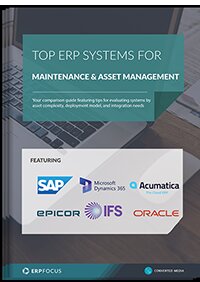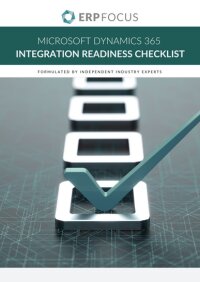A beginner’s guide to ERP integration
ERP integration is crucial for businesses that rely on legacy systems or specialized tools.
Many businesses stick to these specific systems because they seemingly fit their operational needs. Before long, ERP system integrators become necessary for these processes to scale efficiently.
What is ERP integration?
ERP integration connects your ERP system with other business tools for smooth communication and data flow. This ensures all systems work together efficiently. For example, an online storefront may handle orders and payments, while the ERP system manages fulfillment. With low order volumes, you might manually transfer data, but an integrated ERP system streamlines the process and saves time.
Check out our ERP comparison to find out what popular ERP systems can offer your business
Consider a sophisticated product management system that includes specific chemical formulations and tightly managed temperature and pressure measurements. This system must integrate with your ERP's production order scheduling and bills of material management.
Integration requirements may also be external. For instance, a customer may send a high volume of orders and expect a quick turnaround, necessitating automatic integration of these orders with your internal ERP order fulfillment systems.
What are the common methods of ERP integration?
Common methods include point-to-point integration, custom integrations, EDI, APIs, and using an Enterprise Service Bus (ESB).
Point-to-point integration
Point-to-point integration is often described as the simplest model: one system sends a message, and another system receives it. At first glance, our storefront-to-ERP example fits this, but does it really?
To create a sales order in an ERP, a valid customer record is required. For new customers, this record must first be created. If product codes differ between the storefront and ERP, a translation table is needed. Payments, shipping methods, tax jurisdictions, and delivery dates also need to sync across systems.
While point-to-point suggests a single transmission to a single reception, even simple examples often involve multiple reception points and bidirectional transmissions. Integration quickly becomes more complex than it seems, with various channels to develop and manage.
Custom integrations
As businesses recognize the complexities of integration, many choose custom ERP integrations.
Most ERP systems include a library of pre-defined connections that allow customized programming to link to the ERP while maintaining all validation and rules. This approach enables developers to effectively "mirror' keyboard input through programming.
A set of custom programs can handle our entire set of integrations connecting our web storefront to ERP. We have a test for a new customer ID and, conditionally, for creating the new customer record.
We receive the new sales order. We use a matrix to translate between different versions of product identification used in ERP. Additionally, we can link backward from ERP to the storefront to update the shipping date in ERP, notifying the customer when to expect delivery.
EDI
Electronic Data Interchange (EDI) is a reliable integration method that enables businesses to communicate quickly and accurately without manual delays.
Early adopters, like automobile manufacturers, use EDI to facilitate seamless exchanges of documents like purchase orders and shipping updates.
For instance, a customer’s purchase order can instantly become a sales order in the supplier’s ERP system, which then sends an Advance Shipping Notice (ASN) back to the customer.
While not the newest technology, EDI remains a proven, efficient way to streamline processes and connect systems effortlessly.
ERP API integration
Modern systems, including integrated ERP systems, are often equipped with APIs (Application Programming Interfaces). APIs provide explicit guidelines for interacting with the system, including data structures, routine specifications, and other components necessary for seamless communication.
Developers can use APIs to match the ERP system with other systems, facilitating the desired communications. While this approach still involves custom integration, it simplifies the development process and ensures that the integration adheres to the rules set by both systems.
ESB
An Enterprise Service Bus (ESB) represents a more advanced category of software for integration. Businesses can use an ESB in conjunction with ERP and other essential systems. The ESB acts as a communication medium, "listening" for messages sent by one system and "translating" them into the appropriate language for the receiving system.
An ESB can route messages between various services, manage data transformation, handle errors and exceptions, and enforce quality control. However, while ESBs offer significant benefits, they are also complex, expensive, and typically used by larger businesses with extensive communication needs.
ESBs are typically used by large enterprises, as smaller businesses might not have the resources required for their implementation and maintenance. However, for those who can invest, an ESB can provide a centralized integration solution, albeit one that introduces a potential single point of failure if not managed correctly.
Choosing the right ERP integration strategy
Selecting the right ERP integration strategy depends on several factors, including the complexity of your systems, the volume of data you handle, and your budget. Whether you opt for point-to-point integration, custom integrations, EDI, APIs, or an ESB, the goal is to create a cohesive system that enhances operational efficiency.
Integrated ERP systems are not just about connecting different software; they are about creating a unified approach to managing all aspects of your business. The right strategy will depend on your specific needs and the tools at your disposal.
In summary
ERP systems are like Swiss army knives, offering versatile tools for businesses. However, many companies also rely on other systems, from legacy platforms to specialized solutions, which need integration to work seamlessly together.
The goal is a fully unified system for all users, but until then, ERP integration bridges the gap. Thanks to advancements in technology, APIs, and methods like web services, XML, and JSON, integration is now easier and more reliable than ever.
Free white paper

ERP Requirements template
Plan your ERP selection using our requirements template with 100 features in an editable spreadsheet. Include special requirements and extra detail in this exclusive template.

Featured white papers
-

Top ERP Software for Maintenance & Asset Management
Compare ERP systems with CMMS and EAM capabilities to manage your assets smarter
Download -

Microsoft Dynamics 365 integration readiness checklist
Get your free, practical checklist to assess whether third-party or legacy systems are ready to integrate with Dynamics 365
Download
Related articles
-

CMMS, EAM or ERP: Which is right for your business?
Discover the differences between CMMS, EAM, and ERP systems to choose the best fit for managing a...
-

CMMC Compliance: What Aerospace and Defense Manufacturers Need to Know
Key insights on CMMC compliance, deadlines, and securing DoD contracts with CMMC 2.0 certificatio...
-

When is it time to replace a legacy ERP system?
Replacing your legacy ERP system with new software can revitalize your business operations.

